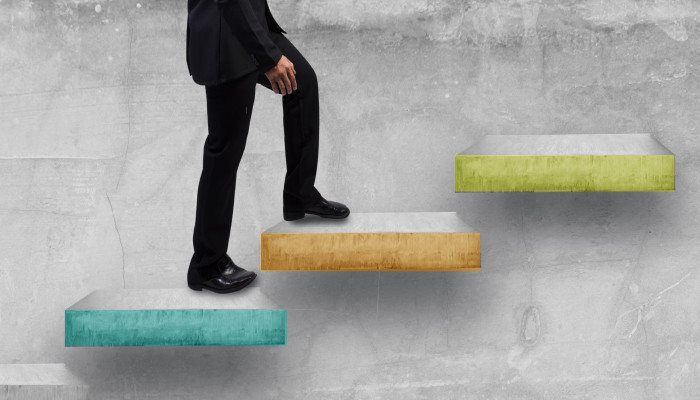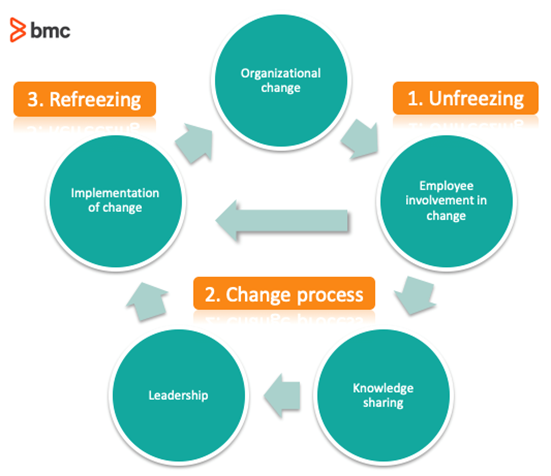| |
Change behavior—how humans accept, embrace, and perform change—is the core of modern change management. ITSM frameworks incorporate various approaches to change management, but one started it all: Kurt Lewin’s 3 Stage Model of Change.
Lewin’s Model of Change
Lewin’s model was developed by a pioneering psychologist in the field of social and organizational psychology in the face of change. The model is based on three steps, or stages, that together make up the change process. These are:
- Unfreeze – Prepare an organization for coming change by communicating why change is needed, ideally breaking down mindsets and behaviors that resist change.
- Change or Transition – During the actual change, organizations implement new behaviors, processes, and beliefs.
- Refreeze – Once the change is done, an organization solidifies it to reinforce new behaviors and processes, rewarding new approaches and preventing a return to the old.
Initially a popular concept, current ITSM thinking criticizes Lewin’s model for being too simplistic and abstract to manage change in a real way. In today’s speedy, complex, and dynamic landscape of enterprise IT, the three-step model provides limited actionable guidance.
Still, understanding these steps provides an essential view into change management, so let’s have a look.
Understanding Lewin’s Change Model
A leader in change management, Kurt Lewin was a German-American social psychologist in the early 20th century. Among the first to research group dynamics and organizational development, Lewin developed the 3 Stage Model of Change in order to evaluate two areas:
- The change process in organizational environments
- How the status-quo could be challenged to realize effective changes
Lewin proposed that the behavior of any individual in response to a proposed change is a function of group behavior. Any interaction or force affecting the group structure also affects the individual’s behavior and capacity to change. Therefore, the group environment, or ‘field’, must be considered in the change process.
The 3 Stage Model of Change describes status-quo as the present situation, but a change process—a proposed change—should then evolve into a future desired state. To understand group behavior, and hence the behavior of individual group members during the change process, we must evaluate the totality and complexity of the field. This is also known as Field Theory, which is widely used to develop change models including Lewin’s 3 Stage Model.
Lewin’s 3 Stages of Change
Let’s look at how Lewin’s three-step model describes the nature of change, its implementation, and common challenges:
Step 1: Unfreeze
Lewin identifies human behavior, with respect to change, as a quasi-stationary equilibrium state. This state is a mindset, a mental and physical capacity that can be almost absolutely reached, but it is initially situated so that the mind can evolve without actually attaining that capacity. For example, a contagious disease can spread rapidly in a population and resist initial measures to contain the escalation. Eventually, through medical advancement, the disease can be treated and virtually disappear from the population.
Lewin argues that change follows similar resistance, but group forces (the field) prevent individuals from embracing this change. Therefore, we must agitate the equilibrium state in order to instigate a behavior that is open to change. Lewin suggests that an emotional stir-up may disturb the group dynamics and forces associated with self-righteousness among the individual group members. Certainly, there are a variety of ways to shake up the present status-quo, and you’ll want to consider whether you need change in an individual or, as in a company, amongst a group of people.
Let’s consider the process of preparing a meal. The first change, before anything else can happen, is to “unfreeze” foods—preparing them for change, whether they’re frozen and require thawing, or raw food requiring washing. Lewin’s 3 Step Model believes that human change follows a similar philosophy, so you must first unfreeze the status-quo before you may implement organizational change.
Though not formally part of Lewin’s model, actions within this Unfreeze stage may include:
- Determining what needs to change.
- Survey your company.
- Understand why change is necessary.
- Ensuring support from management and the C-suite.
- Talk with stakeholders to obtain support.
- Frame your issue as one that positively impacts the entire company.
- Creating the need for change.
- Market a compelling message about why change is best.
- Communicate the change using your long-term vision.
Step 2: Change
Once you’ve “unfrozen” the status quo, you may begin to implement your change. Organizational change in particular is notoriously complex, so executing a well-planned change process does not guarantee predictable results. Therefore, you must prepare a variety of change options, from the planned change process to trial-and-error. With each attempt at change, examine what worked, what didn’t, what parts were resistant, etc.
During this evaluation process, there are two important drivers of successful and long-term effectiveness of the change implementation process: information flow and leadership.
- Information flow refers to sharing information across multiple levels of the organizational hierarchy, making available a variety of skills and expertise, and coordinating problem solving across the company.
- Leadership is defined as the influence of certain individuals in the group to achieve common goals. A well-planned change process requires defining a vision and motivation.
The iterative approach is also necessary to sustain a change. According to Lewin, a change left without adequate reinforcement may be short-lived and therefore fail to meet the objectives of a change process.
During the Change phase, companies should:
- Communicate widely and clearly about the planned implementation, benefits, and who is affected. Answer questions, clarify misunderstandings, and dispel rumors.
- Promote and empower action. Encourage employees to get involved proactively with the change, and support managers in providing daily and weekly direction to staff.
- Involve others as much as possible. These easy wins can accumulate into larger wins, and working with more people can help you navigate various stakeholders.
Step 3: Refreeze
The purpose of the final step—refreezing—is to sustain the change you’ve enacted. The goal is for the people involved to consider this new state as the new status-quo, so they no longer resist forces that are trying to implement the change. The group norms, activities, strategies, and processes are transformed per the new state.
Without appropriate steps that sustain and reinforce the change, the previously dominant behavior tends to reassert itself. You’ll need to consider both formal and informal mechanisms to implement and freeze these new changes. Consider one or more steps or actions that can be strong enough to counter the cumulative effect of all resistive forces to the change—these stronger steps help ensure the new change will prevail and become “the new normal”.
In the Refreeze phase, companies should do the following:
- Tie the new changes into the culture by identifying change supports and change barriers.
- Develop and promote ways to sustain the change long-term. Consider:
- Ensuring leadership and management support and adapting organizational structure when necessary.
- Establishing feedback processes.
- Creating a rewards system.
- Offer training, support, and communication for both the short- and long-term. Promote both formal and informal methods, and remember the various ways that employees learn.
- Celebrate success!
Lewin’s Change Model and Modern Organizations
While Lewin’s Change Model has been called simplistic, a straightforward approach can often be more effective. WIth an understanding of the clear steps above, you can make positive and lasting changes as your organization evolves.
Because Lewin’s Model of Change is intuitive and makes it easy to understand how changes occur individually and as a group, you can concentrate on moving forward effectively. When more complex modern change management frameworks are not working, returning to these fundamentals about social behavior in light of change can help you move forward. Models may change, but human nature does not.
Additional resources
- BMC Business of IT Blog
- IT Leadership & Best Practices, a multi-part Guide
- What Is Goodhart’s Law? Balancing Measurement & Authenticity
- The Fourth Industrial Revolution Explained
- Business vs IT vs Digital Transformation: Strategy Across 3 Critical Domains
These postings are my own and do not necessarily represent BMC's position, strategies, or opinion.
See an error or have a suggestion? Please let us know by emailing [email protected].








